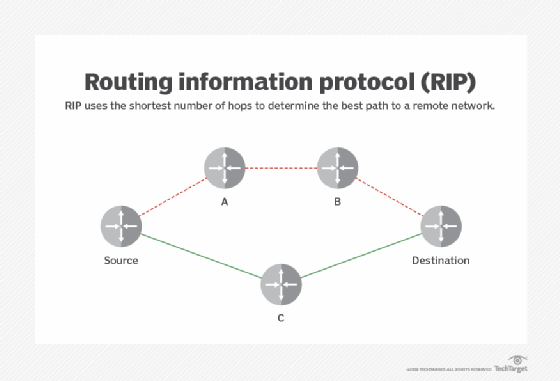What is Routing Information Protocol (RIP)?
Routing Information Protocol (RIP) is a distance vector protocol that uses hop count as its primary metric. RIP defines how routers should share information when moving traffic among an interconnected group of local area networks.
RIP was originally designed for the Xerox PARC Universal Packet protocol suite and was known as Gateway Information Protocol in the Xerox Network Systems protocol suite in 1981. RIP -- defined in Request for Comments 1058 in 1988 -- is easy to configure and easy to use in small networks.
Open Shortest Path First routing has replaced RIP as the most widely used interior gateway protocol in the enterprise. This is mainly due to its simplicity and inability to scale to large, complex networks. In contrast, Border Gateway Protocol (BGP) is a path vector routing protocol used to transfer routing information across autonomous systems on the internet.
How RIP works
RIP uses a distance vector algorithm to decide which path to put a packet on so it arrives at its destination. Each RIP router maintains a routing table listing all the destinations the router knows how to reach and broadcasts it to its closest neighbors every 30 seconds. In this context, neighbors are the other routers that the first router connects directly to. This only includes the other routers on the same network segments as the selected router. The neighbors, in turn, pass the information on to their nearest neighbors, and so on, until all RIP hosts within the network have the same knowledge of routing paths. This shared knowledge is known as convergence.
If a router receives an update on a route and the new path is shorter, it updates its table entry with the shorter path's length and next-hop address. If the new path is longer, it waits through a hold-down period to see if later updates also reflect the higher value. It only updates the table entry if it determines the new, longer path is stable.
If a router crashes or something severs the network connection, the router stops sending and receiving updates to or from its neighbors or along the severed connection. If a given route in the routing table isn't updated across six successive update cycles -- 180 seconds -- a RIP router drops that route and notifies the rest of the network about the problem through its own periodic updates.
Hop counts
RIP only supports 15 hops in a path. By default, a router has one hop if its neighbor owns a destination network and can deliver packets directly without using other routers. Network management terminology describes this as a cost of one. If a packet can't reach a destination in 15 hops, it's considered unreachable.
RIP uses a modified hop count to determine network distance. A modified hop count reflects how network engineers can assign paths a higher cost -- as if they involved extra hops -- if they want to limit or discourage their use. For example, they might assign a satellite backup link a cost of 10 hops to force traffic to follow other routes when available.
Versions of RIP
Three versions of Routing Information Protocol exist:
- RIPv1. Standardized in 1988, RIPv1 is also known as a classful routing protocol because it doesn't send subnet mask information in its routing updates. RIPv1 determines routes based on the Internet Protocol (IP) destination and hop count. The routing table broadcasts to every station on the attached network.
- RIPv2. Standardized in 1998, RIPv2 is also a classless routing protocol because it sends subnet mask information in its routing updates. RIPv2 advanced RIPv1's routing method and included subnet masks and gateways. RIPv2 sends the routing table to a multicast address to reduce network traffic. Additionally, RIPv2 uses authentication for security -- a feature missing from RIPv1.
- RIPng. RIPng is an extension of RIPv2 made to support IPv6, as the previous versions only ran in IPv4.
RIP configuration
Once the involved computers and router interfaces have assigned IP addresses, developers can issue the router RIP command, which tells the router to enable RIP. Then, developers can use the network command, enabling users to identify the networks they want to work with. They only need to specify the networks directly associated with the router.
Users can also configure any port to perform the following actions:
- Prevent RIP packets from being sent or received.
- Receive packets in various formats.
- Send packets formatted for each RIP version to the RIPv1 broadcast address.

RIP timers
RIP timers help regulate performance. They include the following:
- Update timer. This is the frequency of routing updates. Every 30 seconds, IP RIP sends a complete copy of its routing table, subject to split horizon. Internetwork Packet Exchange RIP does this every 60 seconds.
- Invalid timer. This is the absence of refreshed content in a routing update. RIP waits 180 seconds to mark a route as invalid and immediately puts it into hold-down.
- Hold-down timers and triggered updates. This assists with route stability in a Cisco environment. Hold-downs ensure that regular update messages do not inappropriately cause a routing loop. The router doesn't act on nonsuperior new information for a specific period of time. RIP's hold-down time is 180 seconds.
- Flush timer. RIP waits an additional 240 seconds after hold-down before it removes the route from the table.
Poison reverse is another stability feature that assists with routing loops. A poison reverse is a way for a gateway node to tell its neighbor gateways that one of the gateways is no longer connected. The notifying gateway sets the number of hops to the unconnected gateway to 16, a number that indicates the hops are infinite. This tells the neighboring gateways that packets can't get there.
Advantages of RIP
Advantages of RIP include the following:
- Easy to configure and understand.
- Support for almost all routers.
- Promotion of load balancing.
- No requirement for an update every time the topology changes.
Disadvantages and limitations of RIP
Disadvantages of RIP include the following:
- Not always loop-free.
- Only support for equal-cost load balancing.
- Possible occurrences of pinhole congestion.
- Bandwidth-intensive and inefficient.
- Slow convergence in large networks.
- Increased network and processing overhead when compared to static routing.
Users might encounter various limitations while using RIP. For example, RIP increases network traffic due to the checks and updates it performs on neighboring routers every 30 seconds. Furthermore, because RIP only updates neighboring routers, it might forget updates for non-neighboring routers because the information isn't immediately accessible.
Another limitation is the enforcement of the maximum hop count of 15. As a result, it might be hard to access or reach remote routers in large networks. Furthermore, the closest path might not be the shortest path because RIP doesn't consider certain factors when calculating the shortest route.







